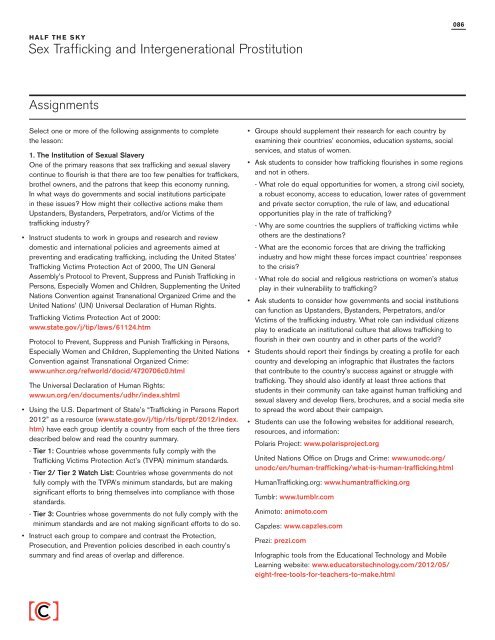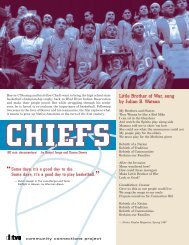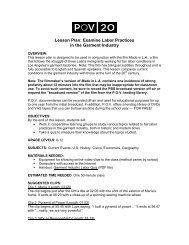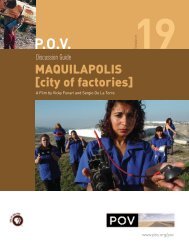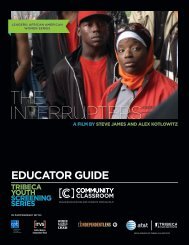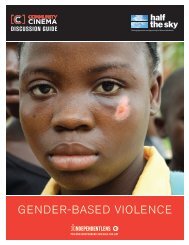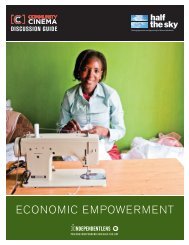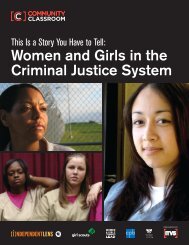LESSON PLANS - ITVS
LESSON PLANS - ITVS
LESSON PLANS - ITVS
- No tags were found...
You also want an ePaper? Increase the reach of your titles
YUMPU automatically turns print PDFs into web optimized ePapers that Google loves.
086HALF THE SKYSex Trafficking and Intergenerational ProstitutionAssignmentsSelect one or more of the following assignments to completethe lesson:1. The Institution of Sexual SlaveryOne of the primary reasons that sex trafficking and sexual slaverycontinue to flourish is that there are too few penalties for traffickers,brothel owners, and the patrons that keep this economy running.In what ways do governments and social institutions participatein these issues? How might their collective actions make themUpstanders, Bystanders, Perpetrators, and/or Victims of thetrafficking industry?• Instruct students to work in groups and research and reviewdomestic and international policies and agreements aimed atpreventing and eradicating trafficking, including the United States’Trafficking Victims Protection Act of 2000, The UN GeneralAssembly’s Protocol to Prevent, Suppress and Punish Trafficking inPersons, Especially Women and Children, Supplementing the UnitedNations Convention against Transnational Organized Crime and theUnited Nations’ (UN) Universal Declaration of Human Rights.Trafficking Victims Protection Act of 2000:www.state.gov/j/tip/laws/61124.htmProtocol to Prevent, Suppress and Punish Trafficking in Persons,Especially Women and Children, Supplementing the United NationsConvention against Transnational Organized Crime:www.unhcr.org/refworld/docid/4720706c0.htmlThe Universal Declaration of Human Rights:www.un.org/en/documents/udhr/index.shtml• Using the U.S. Department of State’s “Trafficking in Persons Report2012” as a resource (www.state.gov/j/tip/rls/tiprpt/2012/index.htm) have each group identify a country from each of the three tiersdescribed below and read the country summary.--Tier 1: Countries whose governments fully comply with theTrafficking Victims Protection Act’s (TVPA) minimum standards.--Tier 2/ Tier 2 Watch List: Countries whose governments do notfully comply with the TVPA’s minimum standards, but are makingsignificant efforts to bring themselves into compliance with thosestandards.--Tier 3: Countries whose governments do not fully comply with theminimum standards and are not making significant efforts to do so.• Instruct each group to compare and contrast the Protection,Prosecution, and Prevention policies described in each country’ssummary and find areas of overlap and difference.●• Groups should supplement their research for each country byexamining their countries’ economies, education systems, socialservices, and status of women.• Ask students to consider how trafficking flourishes in some regionsand not in others.--What role do equal opportunities for women, a strong civil society,a robust economy, access to education, lower rates of governmentand private sector corruption, the rule of law, and educationalopportunities play in the rate of trafficking?--Why are some countries the suppliers of trafficking victims whileothers are the destinations?--What are the economic forces that are driving the traffickingindustry and how might these forces impact countries’ responsesto the crisis?--What role do social and religious restrictions on women’s statusplay in their vulnerability to trafficking?• Ask students to consider how governments and social institutionscan function as Upstanders, Bystanders, Perpetrators, and/orVictims of the trafficking industry. What role can individual citizensplay to eradicate an institutional culture that allows trafficking toflourish in their own country and in other parts of the world?• Students should report their findings by creating a profile for eachcountry and developing an infographic that illustrates the factorsthat contribute to the country’s success against or struggle withtrafficking. They should also identify at least three actions thatstudents in their community can take against human trafficking andsexual slavery and develop fliers, brochures, and a social media siteto spread the word about their campaign.• Students can use the following websites for additional research,resources, and information:Polaris Project: www.polarisproject.orgUnited Nations Office on Drugs and Crime: www.unodc.org/unodc/en/human-trafficking/what-is-human-trafficking.htmlHumanTrafficking.org: www.humantrafficking.orgTumblr: www.tumblr.comAnimoto: animoto.comCapzles: www.capzles.comPrezi: prezi.comInfographic tools from the Educational Technology and MobileLearning website: www.educatorstechnology.com/2012/05/eight-free-tools-for-teachers-to-make.html


